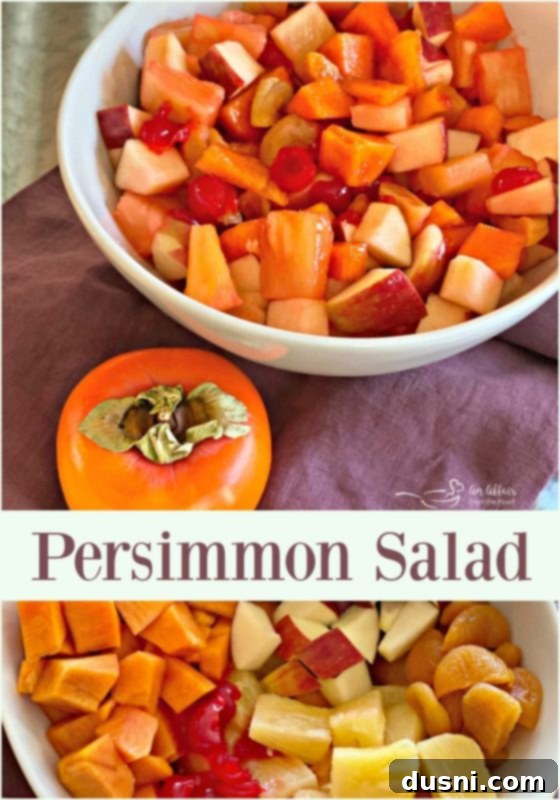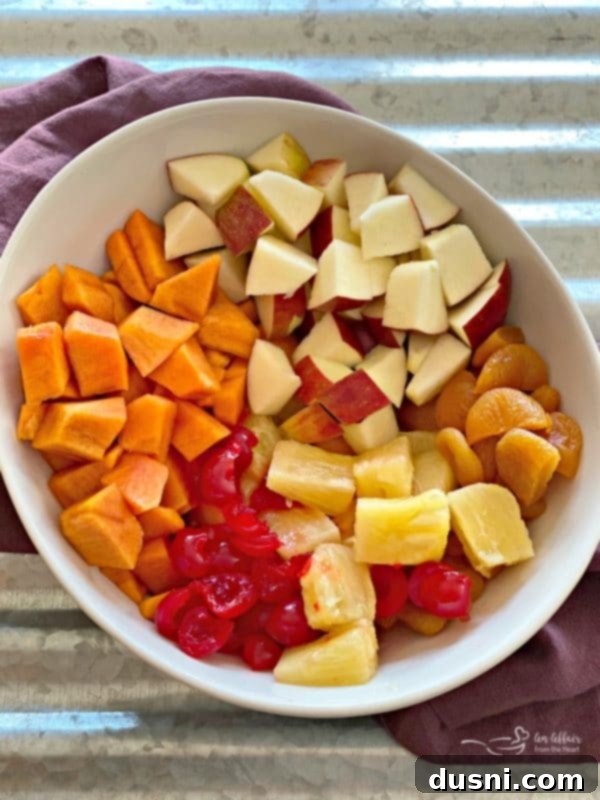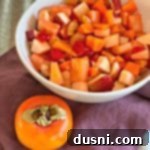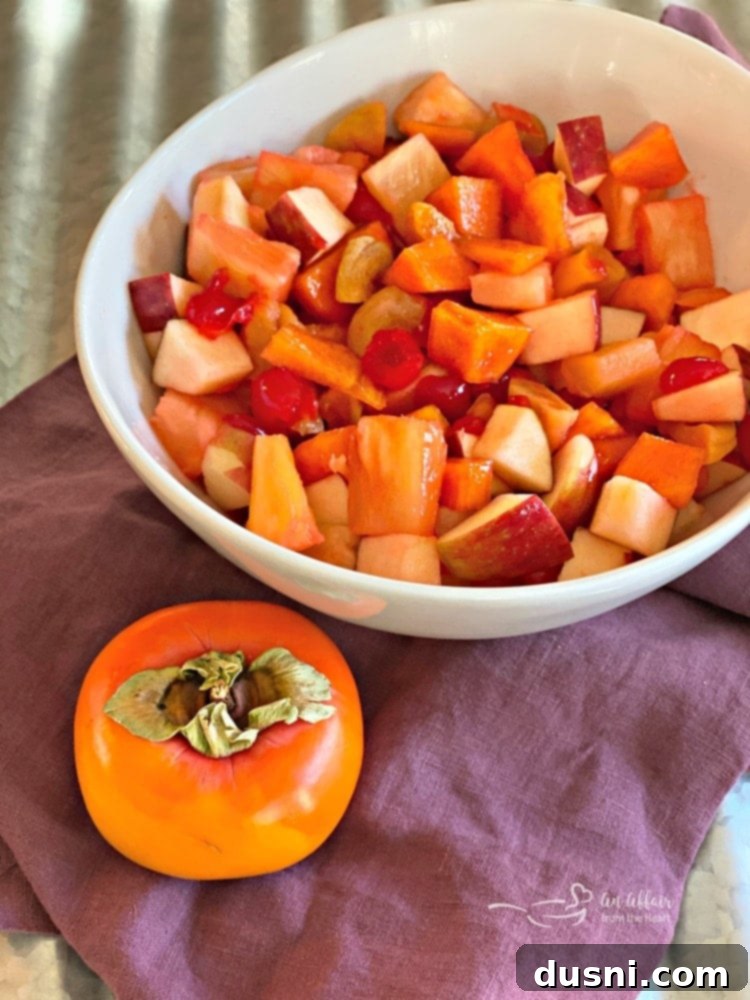Deliciously Simple Persimmon Salad: Your Perfect Winter Fruit Side Dish Recipe
So simple to make, yet incredibly delicious and visually appealing, this Persimmon Salad features a delightful blend of crisp apples, sweet Maraschino cherries, tangy pineapple, and succulent apricots. It’s a truly beautiful and refreshing addition to any winter meal, especially perfect as a vibrant side dish for festive gatherings.

The Persimmon Salad offers a delightful new approach to enjoying this often-misunderstood fruit. For many who are unfamiliar with persimmons, they can seem a bit “persnickety,” as I like to say. Why is that? Well, the truth is, unlocking the persimmon’s true deliciousness requires a keen understanding of its ripeness.
To truly savor the sweet, nuanced flavors of a persimmon, you must consume it at its absolute peak of ripeness. Misjudge this crucial timing, and you’re likely to be met with a mouthful of unpleasant astringency and bitter tannins. The sensation can be quite startling – akin to biting into a raw aspirin, followed by licking a battery, and then stuffing a prickly cactus into your mouth. It’s an experience that can certainly deter first-timers from exploring this exotic fruit further.
Discover the Joy of a Persimmon Salad
However, for those willing to exercise a little patience, the rewards are immense! A perfectly ripe persimmon is a culinary revelation. Its flavor profile is often described as a sublime blend, reminiscent of a sweet apricot drizzled with golden honey, underscored by the crisp, sugary notes of a Red Delicious apple coated in rich caramel. This unique and captivating taste makes it an irresistible addition to any fruit-based dish.
Beyond its exquisite taste, persimmons boast an absolutely gorgeous color, ranging from bright orange to deep reddish-orange, which instantly elevates the visual appeal of any fruit salad. Its vibrant hue adds a festive touch, making it not just a treat for the palate but also for the eyes. This vibrant persimmon salad is a testament to the fruit’s versatility and charm.
Understanding Different Types of Persimmon
Persimmons are traditionally celebrated as a “winter fruit” because they typically reach their peak ripeness during the colder months, primarily in warmer climates. Understanding the different varieties is key to enjoying them. While there are numerous types cultivated globally, you’ll most commonly encounter two main varieties in North American supermarkets: the Fuyu and the Hachiya persimmon.
Beyond these common types, other varieties include Izu, Jiro (often grouped with Fuyu), Suruga, Hanagosho, Midia, and Shogatsu. For those seeking a reliably sweet and less temperamental experience, you’re generally safe selecting any variety that ends in “Maru,” “Jiro,” or “Fuyu” as these are all known for their inherent sweetness.
Conversely, there are dozens of astringent varieties that demand precise timing for consumption. These include popular types like Eureka, Tamopan, Tanenashi, and Gailey. These varieties must be eaten when they are extremely ripe – often to the point of being soft and jelly-like – to avoid their harsh, tannic qualities.
While persimmons originated in Asia, their popularity has led to cultivation in many other regions, including the United States. The most crucial distinction to grasp is the difference between sweet (non-astringent) and astringent persimmons. Sweet varieties, like the Fuyu, are much more forgiving, offering a pleasant taste even if slightly under-ripe.
Astringent varieties, while capable of exquisite flavor when perfectly ripe, are notoriously demanding. If you’re ever in doubt about a persimmon’s ripeness, especially with an unfamiliar variety, try a tiny piece on the tip of your tongue. If your tongue reacts with a raw, fuzzy, drying sensation – almost like you’ve licked a fuzzy tennis ball – then it’s a clear sign to wait before consuming any more.
Fuyu persimmons are celebrated for their delightful sweetness and, importantly, can be enjoyed while still relatively firm. Their appearance is distinct: a squat, wide, and round shape, often compared to a beefsteak tomato. This firm texture makes them ideal for slicing and dicing, allowing them to hold their shape beautifully in dishes like this persimmon fruit salad.
The Hachiya persimmon, on the other hand, is only truly good when it is exceedingly ripe, bordering on overripe. In fact, don’t be tempted to discard a Hachiya just because it looks too soft or bruised; that’s precisely when it’s at its flavorful best. Hachiya persimmons have a more tapered, elongated shape, resembling a turnip or an acorn.
As mentioned, Hachiyas are intensely astringent if not consumed at their peak ripeness. The Fuyu variety offers more flexibility since its astringency is much less pronounced if it hasn’t reached full ripeness. Therefore, for most culinary applications, especially for salads where you want distinct fruit pieces, I highly recommend seeking out the Fuyu persimmon. Its firm, sweet texture makes it a joy to work with and eat.

Make sure to save this delightful persimmon salad recipe to your favorite Pinterest board so you can easily find it whenever you crave a taste of winter freshness!
How Do You Know a Persimmon Is Ready To Eat?
Determining the perfect ripeness of a persimmon depends greatly on its type. For the Fuyu, the fruit will develop a texture akin to a ripe melon – it should feel soft yet still firm to the touch, bursting with juicy sweetness. Its skin will be a vibrant, even orange color.
The Hachiya, conversely, will transform into a much softer, almost mushy consistency when ripe. Imagine the texture of an overripe banana, perfect for mashing into banana bread. I understand this texture might be off-putting for some, but I assure you, the flavor at this stage is truly exquisite and well worth experiencing. Perhaps a more appealing description would be a luxurious, pudding-like texture, rich and sweet.
When preparing this particular persimmon fruit salad, the Fuyu persimmon is generally the preferred choice if you desire distinct, firm pieces of fruit that stand out. Its ability to retain its shape makes it ideal for a chunky fruit salad. However, if you opt for a Hachiya, thoroughly mash it, and it will effortlessly blend into a wonderfully flavorful dressing component, adding its deliciously complex layers of sweetness and aroma. Either choice will infuse your fruit salad with an exceptional flavor profile.
How Do You Eat a Persimmon Fruit?
Eating a persimmon is quite simple once you know how. First, wash the fruit thoroughly. Then, gently cut off the leafy green top. You can then slice it in half. For Fuyu persimmons, you can easily cut them into chunks or slices with the skin on; the skin is slightly waxy but perfectly edible and adds a bit of fiber. For a really ripe Hachiya, which will be very soft, it’s often easiest to cut it in half and simply scoop out the luscious, jelly-like pulp with a spoon, much like eating a kiwi. This method prevents the skin from breaking and making a mess.
What Is Persimmon Fruit Good For? Exploring its Health Benefits
Beyond their delightful taste and beautiful appearance, persimmons are a nutritional powerhouse, packed with an impressive array of vitamins and fiber. These remarkable fruits are naturally low in fat and exceptionally high in beneficial minerals, making them a fantastic addition to a healthy diet.
Persimmons are an excellent source of Vitamin C, a powerful antioxidant known for boosting the immune system and promoting healthy skin. They also provide a wealth of B vitamins, crucial for energy metabolism and nervous system function, alongside a significant amount of Vitamin A, which is vital for vision, immune function, and skin health. In addition to these vitamins, you’ll benefit from a generous supply of essential minerals, including copper, which aids in iron absorption and energy production; manganese, important for bone health and metabolism; and potassium, essential for maintaining healthy blood pressure and fluid balance. Their high fiber content also supports digestive health, promoting regularity and contributing to a feeling of fullness. Incorporating persimmons into your diet, perhaps in a delicious persimmon fruit salad, is a wonderful way to enjoy these numerous health advantages.

Enjoy Your Vibrant Persimmon Fruit Salad!
This delightful persimmon fruit salad recipe comes to me from my thoughtful cousin, Shirley, who annually blesses me with a shipment of fresh persimmons from sunny California. This year, she generously shared this fantastic fruit salad recipe, which quickly became a new family favorite. While persimmons might not be a common staple in all parts of the country, especially regions like the Midwest, you’ll most likely find this exquisite winter fruit readily available at major supermarkets or specialty grocery stores such as Fresh Thyme or Whole Foods during this time of year.
As someone who adores creating fresh and vibrant dishes, I have a collection of fruit salad recipes, but none quite like this unique persimmon fruit salad. It’s truly a standout!
So, I encourage you: be brave, step out of your culinary comfort zone, and experience something wonderfully new if you’ve never tasted a persimmon before. This fruit is genuinely unique, offering a delicious and memorable flavor profile that’s distinct from any other. This easy persimmon salad is the perfect introduction.

Shirley’s original persimmon salad recipe calls for a harmonious blend of crisp Fuyu Persimmons, freshly diced apple with the skin on for added texture and nutrition, canned pineapple chunks for a tropical tang, vibrant Maraschino cherries for sweetness and color, and chewy dried apricots. Of course, if you have access to fresh, ripe apricots, they would also work beautifully and lend a different, equally delicious dimension to the salad. I made a slight tweak to Shirley’s recipe to better suit my preference: I found that the cherry juice, while delicious, made an already naturally sweet fruit salad a touch too sweet for my liking, so I balanced it by adding a bit more pineapple juice for an extra layer of refreshing tartness and a more complex flavor profile.
The result was absolutely loved by everyone who tried it! This persimmon fruit salad is not only incredibly flavorful but also wonderfully colorful and visually appealing. Its vibrant hues make it a fantastic addition to any dining table, particularly for special occasions and holiday spreads, where it truly shines as a refreshing and elegant side dish.
Other Great Ways to Use Persimmons:
- Persimmon Cookies: A delightful baked treat showcasing the fruit’s natural sweetness.
- Persimmon, Pomegranate, and Spinach Salad: A savory salad blending the fruit with leafy greens and other vibrant ingredients.
- Persimmon Apple Cider Mimosa: A sophisticated and festive drink perfect for brunch.
- Fall Harvest Salad: Incorporate persimmons into a hearty seasonal salad alongside other autumnal produce.
- Persimmon Ginger Sorbet: A refreshing and light dessert, perfect for cleansing the palate.

If you whip up this easy persimmon salad recipe now, you’ll be able to savor its fresh, chilled goodness in just a couple of hours after it’s had time to meld its flavors in the fridge. So don’t delay, let’s get to preparing this vibrant and healthy winter side dish! 
LIKE THIS RECIPE?
Don’t forget to give it a ⭐️⭐️⭐️⭐️⭐️ star rating and
leave a comment below the recipe!

Print Recipe
Persimmon Salad
Ingredients
- 2 Fuyu persimmons peeled and diced
- 1 large apple diced, skin left on (e.g., Honeycrisp or Fuji)
- 5 ounces Maraschino cherries halved, reserving a small amount of juice
- 1 cup dried apricots halved or quartered for smaller pieces
- 1 20-ounce can of pineapple chunks drained, reserving juice
- 2 Tablespoons Maraschino cherry juice (from canned cherries)
- 4 Tablespoons Pineapple juice (from canned pineapple)
Instructions
-
In a large mixing bowl, gently combine all the prepared fruit ingredients: diced persimmons, diced apple, halved Maraschino cherries, halved dried apricots, and drained pineapple chunks. Pour in the cherry juice and pineapple juice, stirring gently to ensure all fruits are lightly coated.
-
Once thoroughly mixed, cover the bowl tightly and place it in the refrigerator. Allow the fruit salad to chill for at least two hours. This chilling period is crucial for the flavors to meld beautifully and for the dried apricots to rehydrate, becoming plump and tender.
-
Your vibrant and refreshing Persimmon Salad is ready to serve once the apricots are fully rehydrated and the salad is thoroughly chilled. Enjoy this delicious and pretty winter side dish!
Nutrition
